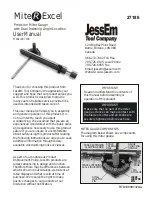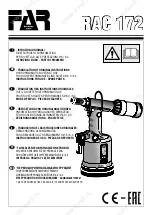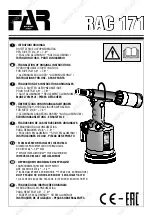
FIG. 13
FIG. 12
FIG. 14
Note: Always loosen the gauge clamping handle
on the miter gauge face before pulling any
locator pins. Then tighten the clamping handle
after your desired position is achieved.
SETTING AT ZERO & EVERY FIVE DEGREES
12. To position the gauge at 90 degrees, place
the small locator pin in the hole marked “0”, just
left of center. Place the large locator pin in the
center hole (above the zero on the angle scale).
The large locator pin can now also be used to
locate positive stops at every five degrees left or
right on the scale. Simply pull out the large
locator pin and angle the fence to move the
gauge in any five degree increment and then
push the pin into your desired position (Fig. 12).
USING THE 2.5 DEGREE SETTING
14. There is only one 2.5 degree pin location. It
is the hole on the far right side of the gauge.
Placing the small locator pin in the 2.5 degree
position and then using the large locator pin to
give you positive stops between every five
degrees in either the left or right direction.
A setting for 22.5 degrees is shown in Fig. 14.
To use the gauge in a normal or manual miter
gauge mode put the large locator pin in the pin
storage hole (see Fig. 12).
SMALL
LOCATOR
PIN
LARGE
LOCATOR
PIN
SMALL
LOCATOR
PIN
LARGE
LOCATOR
PIN
SMALL
LOCATOR
PIN
LARGE
LOCATOR
PIN
USING THE .5, 1, 1.5, & 2 DEGREE LOCATORS
13. The numbered peg holes on the left and
right side are used to offset the gauge by .5, 1,
1.5, 2, and 2.5 degrees from every five degrees
on the angle scale. Using the small locator pin in
the holes on the left will give you that number of
degrees left of every five degrees. Using the pin
holes on the right will give you that number of
degrees to the right of every five degrees. For
example, placing the small locator pin in the (1)
degree hole on the left gives you (1) degree left
of every 5 degrees. Placing the small locator pin
in the (1) degree hole on the right gives you (1)
degree to the right of every five degrees. Fig. 13
shows the small peg in the 1 degree hole on the
left side. This offsets the gauge by 1 degree
increments to the left of every five degrees as
you rotate the fence and use the large locator
pin to lock in the actual position. The gauge is
shown at 6 degrees in Fig. 13. (1) degree left of
5 degrees.
FITTING THE BAR IN THE MITER SLOT
11. The bar on the miter gauge has two hex key
adjustment locations to remove any side to side
slop in the miter slot. Adjusting the fit can be
done easily from above the table. Turn the hex
key clockwise to tighten and counter clockwise
to loosen. Alternate between the two hex key
locations and make only slight adjustments
while testing the movement of the gauge in the
track (Fig. 11).
FIG. 11
USING THE DUAL INDEXING ANGLE LOCATING
Attached to the gauge face are two brass
locator pins, a large and a small. These pins
are used together to achieve any angle location
down to ½ degrees. The following instructions
explain how the dual indexing system works.
HOLE
FOR PIN
STORAGE
ANGLE
SCALE























